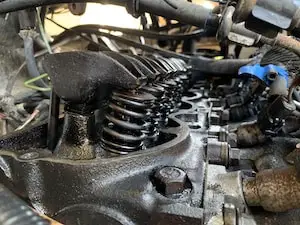When I was restoring and improving the performance of one of my classic cars, I came across the idea that my car battery could be moved from the front of the car to the back (in the trunk). As I explored this option I learned I would need to switch to a safer sealed battery type and I learned just how the battery would need to be grounded to sufficiently provide power to the engine bay at the front of the car.
I came across trunk relocating kits that did not seem very good due to the fact that the wires were undersized and the makers of the kit clearly did not have a good understanding of how the battery needs to be properly grounded.
My biggest question was, where should I ground the battery when moving the battery to the trunk?
A car battery relocated to the trunk is best grounded by connecting the (-) terminal to the closest place on the chassis of the car as possible. An additional connection should be made between the chassis and the engine block at the front of the car. Often a connection between the chassis and the car body is required as well.
Properly Grounded Trunk Battery
Batteries mounted in the engine bay are grounded to the engine block. Often to the starter, and make a connection with the frame as well.
As I was researching just what I needed to do to move the battery to the trunk, I wondered if I needed to run the ground back up to the front of the car to the engine block, or was straight to the body good enough?
I was of course willing to do whatever was required for a stable connection and reliable electrical system and after my researching and the hands on experience, I learned that there are many ways to ground the battery, but some ways are far superior than the others. These are 4 keys of a properly mounted trunk battery to keep in mind for your own battery relocation job.
1.Short Connection to Ground
A short connection to ground is best where possible. Current flows to the path of least resistance and so we want to make that path as short as possible.
Even if you decide to run a common ground cable all the way to the front of the car, it is a good idea to ground the battery as close as you can to the body of the car.
A short connection from the battery to the frame of the car, and a short connection from the frame of the car to the engine should provide just as good of a ground as running a cable all the way to the front of the car provided the connections are clean and secure.
2.Grounding Connections Between Every Part of the Car
Some do not realize that just because there is a good ground connection to the frame, that does not mean there is a good connection to the engine. Or from the frame to the body.
Many of the parts of a car are insulated from each other and so a connection must be bridged between them.
The engine block is insulated from the frame of the car by rubber engine mounts that absorb vibrations.
And the car body is insulated from the frame by body mounts also made of rubber to absorb vibrations.
For these reasons, most cars have multiple ground connections and sometimes a connection from the battery to the frame, the body of the car, and the engine block.
3.Secure Clean Battery Ground Connections
Secure connections are one of the most important steps in this process because this is where most problems stem from.
One of the major mistakes that I commonly see people make when making a new grounding point is to not remove the paint in the area. The paint must be scraped or sanded or otherwise removed to allow proper contact to be made.
By using a lock washer, or star washer, you can ensure that the mount stays tight for good.
Pro Tip: Dielectric grease will help reduce corrosion and ensure a good connection
A hole tapped into the frame of the car will provide a secure mounting location.
For the connection to the engine block, a vacant bolt hole on the block is generally the best connection location.
4.Properly Sized and Insulated Wires
Size depends on current flow and the distance of the run.
But in general 4 gauge wire is used for most car battery wiring on short runs.
Keep in mind is bigger is better (within reason of course).
A trick that can be used here is if you are interested in running two cables the length of your car, use a set of large gauge long jumper cables and simply create a new connection on the ends of the cables.
The positive and negative wires should be the same size. So if you run a (+) and (-) wire the length of the car, use the same gauge wiring.
Benefits of a Trunk Mounted Battery
Why are Some Cars Made with the Battery in the Trunk
Plenty of cars are currently being made with the battery located in the back of the car but one that I am familiar with is BMW seems to have several cars that have their car battery in the trunk.
Car from the factory with a trunk mounted battery ground them right to the body.
The battery in the trunk has two potential benefits:
- Better weight distribution – Batteries are heavy. And to improve performance, there is something to be said about moving a 40 pound battery from hanging over the front bumper of an already front-heavy car to the back of the car.
- Saves space in the engine compartment – A lot of cars that design their battery to be located in the trunk seem to have extra full engine compartments and space saving is a primary reason for the car makers to relocate the battery to the back.
These may be slight differences but can make big improvements on the right application.
Reasons to NOT have the Car Battery in the Trunk
Hydrogen sulfide is released from unsealed car batteries when the battery is overcharged.
A lot of batteries are unsealed and can be a significant hazard and the unsealed lead-acid batteries should not be relocated to the trunk.
Rather, a SEALED car battery can be used that does not emit gases and you are safe and good to go!
To read more on sealed vs unsealed batteries check out my other article all about that!
Another downside is a battery in the trunk leaves room for less groceries. It takes up some of that precious trunk space.
Relocating the car to the trunk can cause grounding issues – so make sure it is grounded properly!


